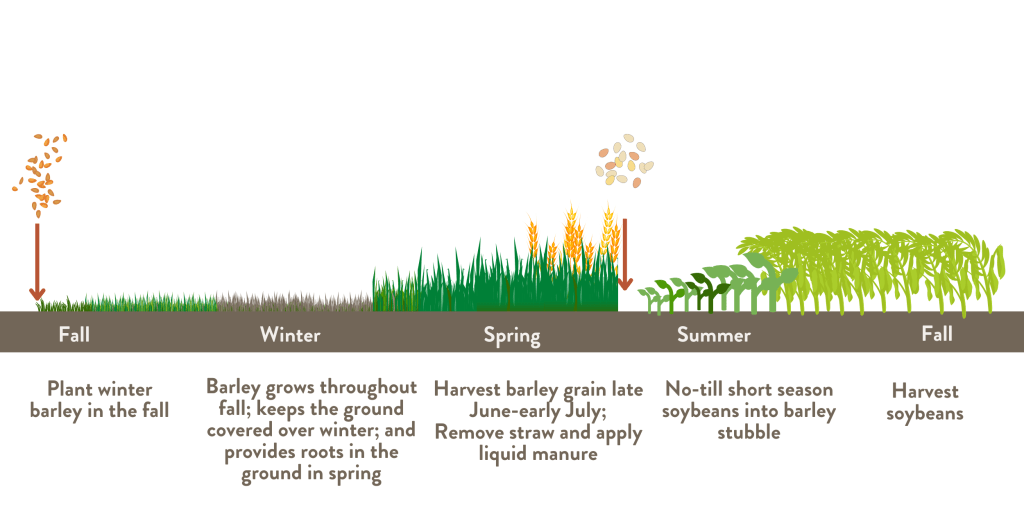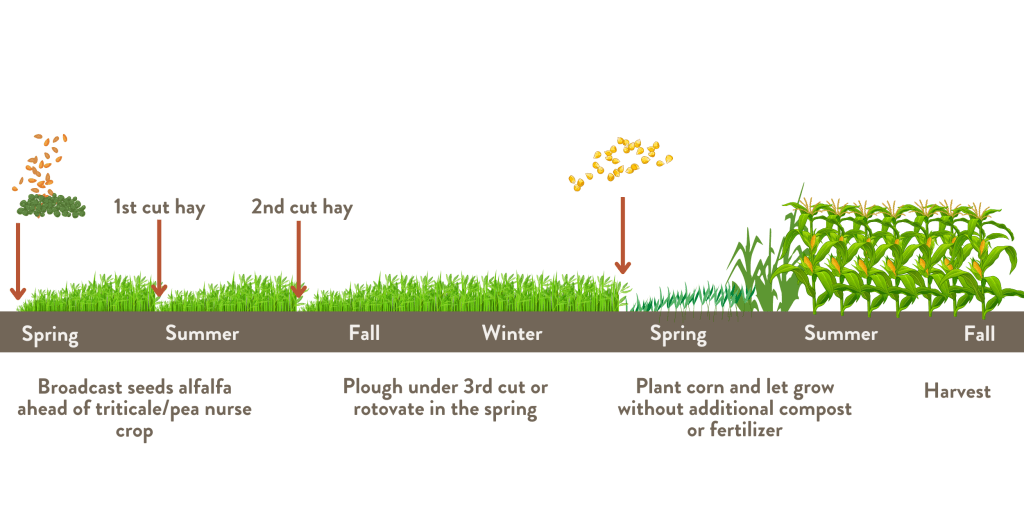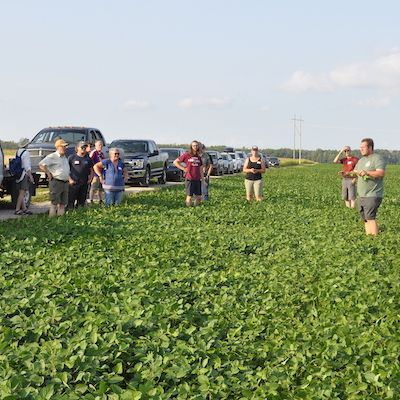By Jackie Clark
As the name suggests, 3Gen Organics is a multi-generational farm. For the Israel family, their choice of name is a reminder to learn from the generations that came before, and be mindful of the ones that will come after.
The Israels farm 1200 acres of certified organic crops on clay loam soils, and raise farrow to finish swine in Wellington county. They engage in a lot of direct marketing — one of many reasons they are committed to producing high quality food in an ecological way and continual improvement.
“I get to farm with my parents and grandparents every day,” explains Brett Israel, the youngest generation of the Israel family. “I’m always reminded that we think today we might know it all, but history has shown us that there’s lots of evolution to come in our practices.”
This mindset makes Brett an ideal collaborator for research. Since 2020, Brett has been a part of Agriculture and Agri-Food Canada’s Living Lab-Ontario project, working alongside EFAO, AAFC and Environment and Climate Change Canada scientists and other farmers towards common goals. Other project partners include the Ontario Soil and Crop Improvement Association, Ontario Soil Network, and several Conservation Authorities.
The mission of Living Labs-Ontario is to support on-farm research to reduce tillage in agricultural systems, with the goal of reducing soil and nutrient runoff from agricultural land into Lake Erie, improving water quality, building soil health and increasing biodiversity.
“The farming world continues to evolve. One of the fun parts about being part of a research project is seeing how we can be a part of that,” says Israel. His goal in the project was to investigate how organic farmers can grow high yielding corn and soybeans with reduced tillage. Tillage takes time, labour and fuel, and fewer passes would decrease soil disturbance and equipment wear and tear.
Brett got some inspiration from his family’s successful use of small grains in crop rotations. They know that, planted early and at high seeding rates, small grains can out-compete weeds and perform well with minimal tillage.
“How do we take the principles of best management practices for our small grains, and utilize the same philosophy to have greater success growing row crops like corn and soybeans?” asks Brett — a question he’s been investigating for three years now.
Double-cropped soybeans
Prior to participating in Living Labs-Ontario, Brett and Jake Munroe from OMAFRA had been experimenting with cereal rye, which is known for its weed- suppressing effects. Leading into the Living Labs – Ontario research period, they established cereal rye in the fall, let it overwinter, roller-crimped the rye in spring and then planted soybeans.
According to Brett, this technique achieved good weed suppression but unimpressive yield. When he looked at the economics, his standard 30-inch beans were more profitable.
Those results were discouraging, but Brett liked the advantages of cereal rye. He wondered if there was another way to use the crop.
In 2021, Brett planted cereal rye in the fall, let it overwinter, and then cut the rye for forage before heads formed. He then ran a high speed disc over the field and immediately planted soybeans.
“We couldn’t get it to work well until we waited before planting the rye,” says Brett. When he cut the rye in May, let it regrow for two weeks, and then disced and planted soybeans in June, he experienced more success. The result was a thick crop of healthy soybean plants, and almost no weeds.
“We were able to maximize solar interception by having the beans solid- seeded. In a dry year that’s important because we’re not getting enough precipitation to have more vegetative growth,” Brett adds.
Typically, the Israels would fall seed cereal rye after a small grain crop. Now, with Living Labs partners, they’re investigating whether cereal rye can be established after a high-moisture grain corn harvest. With shorter-day corn genetics, they could harvest high- moisture corn in late September. Then, it may be possible for the rotation to go from alfalfa-fuelled corn (see below) to rye-based soybean, and then to winter wheat.
In another double-cropping experiment, they planted winter barley in the fall, harvested it the first week in July, then planted super-short season hybrid soybeans.

For the double crop of winter barley and soybeans, Brett planted winter barley at 1.6 million seeds/acre in the fall, harvested it for grain in late June/early July; then removed the straw and applied liquid hog manure. After managing the barley crp, he no-till planted short season hybrid soybeans into the barley stubble at 350,000 seeds/acre. 3Gen Organics invested in grain-drying technology that allows them to harvest barley relatively early at higher moisture. Some advantages of this system include that the application timing of manure fits the 4Rs of nutrient stewardship; the clipping action of the combine during barley harvest acts as good weed control before soybeans, and the seeding date for soybeans means they are past the emergence of many broadleaf weeds and weeds were minimal. If needed, Brett used a tine weeder or rotary hoe to weed the soybeans.
“We have invested in grain- drying technology that allows us to harvest barley a little earlier at higher moisture, get the straw out of the field, and seed the soybeans sooner,” Brett explains.
In 2021 with good precipitation and good harvest conditions in the fall, Brett harvested a barley crop and then grew soybeans that yielded over 30 bu/ac with no additional tillage. However, in 2022’s drought, the same system yielded only 12 bu/ acre soybeans.
“Because of where the prices have gone for commodities in general and the pressures it’s had on the organic space, our break-even yield on the double-cropped beans was 6 bu/acre in 2022,” Brett adds, so even this disappointing yield was financially profitable for the farm.
Alfalfa-fuelled corn

Inspired by Gary Zimmer, Wisconsin farmer and author of The Biological Farmer, the Israel family was also interested in exploring how growing forages could reduce the need for tillage in their field crop production. They use livestock manure for nutrition, but don’t want to overload the soil with phosphorus and potash, which can contribute to harmful environmental impacts in runoff, and encourage annual broadleaf weeds. Instead, with the Living Labs – Ontario initiative, they tried using alfalfa to manage weeds and fix nitrogen for a subsequent corn crop.
Brett broadcast seeded alfalfa at 20-25 lbs/acre in early spring, and then drilled a triticale and pea nurse crop at 100 lbs/ acre. The first cut of forage off the nurse crop was fed to dry sows.
That year, Brett got one or two cuttings from the alfalfa. Feed tests on top growth found crude protein over 35 per cent, estimated to provide 180 lbs/ acre available nitrogen to the next crop. The following spring he used a John Deere high performance disc to work the alfalfa down, and the ground looked prepared for corn planting.
“We thought we had it all figured out,” he adds. “I quickly came to realize that alfalfa is very resilient.”
The alfalfa stand grew back after the corn had been planted, too thick to allow for a decent corn crop.
“We needed to find a different way to manage the alfalfa,” Brett says. That year, he experimented with using a rotavator in some parts of the field in the first week of June, to see if he could salvage some of the corn crop.
“The rotavator did a great job of terminating the alfalfa. The only problem was that the corn planter was already cleaned up and I didn’t want to dirty it again,” he explains. So he used his sweet corn planter to plant an 80- day corn hybrid in June.
“It was out of the ground like a shot,” he said. With no additional tillage or nitrogen, the corn yielded over 240 bu/acre.

For the alfalfa-fueled corn system, Brett broadcast seeded alfalfa at 20-25 lbs/acre in early spring, and then drilled a triticale and pea nurse crop at 100 lbs/acre. The first cut of forage off the nurse crop was fed to dry sows. Feed tests on top growth found crude protein over 35 per cent, estimated to provide 180 lbs/acre available nitrogen to the next crop. Over two years, Brett tried three methods for terminating the alfalfa: moldboard ploughing in the fall, rotovating in the spring, and high-speed discing in the spring. The moldboard plough and rotovator were the better tools, and their use depends on the specific conditions. Spring rotavating will produce better yields when moisture is adequate, and that fall plowing may result in better yields in dry years. In order to maximize soil health, farmers can make thoughtful decisions about when plowing may be appropriate.
These results are “truly game-changing for us,” says Brett. “One of those opportunities that allows organic agriculture to be scaled across more acres and provides a really strong competitive business case to get alfalfa and forages into more of our field crop rotations.”
Along with this exciting success, there also exists risk, challenges, and learning opportunities. Case in point: in places where the alfalfa was not controlled, corn yields were only 40-50 bu/acre.
Learning from this experience, the Living Labs – Ontario team wanted to replicate this result across 50 acres in 2022, testing two different techniques to control alfalfa: letting it overwinter and using a bigger, improved rotavator in the spring, or moldboard plowing in the fall.
“We’ve all been told the moldboard plough is a bad thing; that it shouldn’t be used. We wanted to test what the impact would be on the soil biology,” says Brett.
“What was fascinating was that across all of our corn acres, the plowed down alfalfa was the best corn we had in 2022. Even in peak drought conditions it never showed drought stress.”
In the plowed treatment, 80 day and 96 day corn hybrids yielded 210 bu/acre and 230 bu/acre, respectively. The spring- rotavated fields suffered more under drought conditions, yielding 170 bu/acre.
“Still a very good corn yield,” says Brett, especially in a drought year. “Both systems provided very solid agronomic advantages.”
Brett’s 2021 results indicate that spring rotavating will produce better yields when moisture is adequate, and that fall plowing may result in better yields in dry years. In order to maximize soil health, farmers can make thoughtful decisions about when plowing may be appropriate.
The future on the farm
Each experiment that Brett has completed leads to dozens more questions to explore, he tells EFAO. He’s evaluating interseeding cover crops
to corn, taking a first cut off of alfalfa in the second year, and perfecting the timing of planting and harvesting double-cropped soybeans.
“I think there’s lots of different ways we can use these tools to reduce tillage
in organic systems and produce good crops,” he says. The project is “making organic more scalable for us, and really excites us about the future of our farm.”
These results from the Living Labs—Ontario research at 3Gen Organics have the potential to create more opportunities for larger-scale field croppers to
transition to organic without relying on extensive tillage, and for smaller organic farms to scale up production — a win-win for ecological farmers across the province, and for our soils.
—
Jackie Clark is EFAO’s Small Grains Program Manager, helping encourage farmers to realize the benefits of incorporating small grains in field crop rotations. She is also an accomplished writer and former journalist.

